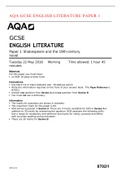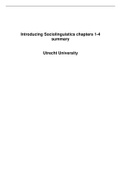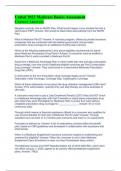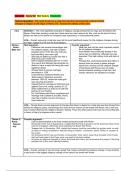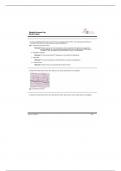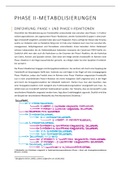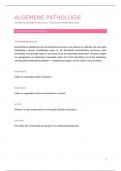Summary Business Research Techniques (based upon the sheets)
1. Introduction to Business Research Techniques (BRT)
Business Research (BR): is a series of well thought out activities and carefully executed
data analysis that helps a manager to avoid, minimize or solve a problem.
Why future managers need to know about BR: Managerial decisions made on the results
of ‘good’ research tend to be more effective. Hunches, intuitions and past experiences are
more likely to be wrong. Managers are then able to perform steer and evaluate:
1. Perform: Undertake research to solve minor problems
2. Steer: interact effectively with researchers and consultants Ranking of terms:
3. Evaluate: To discriminate ‘good’ from ‘bad’ Green
Red
Blue
Facts about BR:
• Researchers with knowledge about research have advantages over those without.
• For knowledgeable managers, research doesn’t need to be intimidating
• BR is really diverse; it can be cheap or expensive.
• For small decisions, managers should carry out their own research.
• There is no such thing as an absolute truth (doesn’t imply any approach is good)
The HALLMARK of ‘good’ BR:
Purposiveness: Knowing the why of a research
Rigor: Ensuring a sound theoretical base and methodological design.
Objectivity: Drawing conclusions based upon facts.
Parsimony: Getting rid of unnecessary information, explain a lot with little.
Replicability: Finding the same results if the research is repeated in similar conditions.
Generalizability: Being able to apply the research findings in a wide variety of different
settings. (should hold for academic research, but not for applied research)
Fundamental research vs Applied research
Fundamental (pure or basic) research: To generate new knowledge about how problems
that occur in several firms can be solved. Based on theory
• Must apply to several organizational settings.
• Mainly within universities or knowledge agencies.
Applied research: To solve a problem faced by a manager.
• Applies to a specific form or company.
• Within firms or research agencies
Deductive - vs inductive research
Deductive research: From theory to data, testing theory.
Inductive research: From data to theory, building theory.
Tilburg University – Pre-master 1
, Summary Business Research Techniques (based upon the sheets)
2. Research Process (R.P.)
The 7-step deductive research process: Inductive (2 different steps):
1. Define the problem.
2. Formulate the problem statement
3. Develop a theoretical framework Provide a conceptual background
4. Choose a research design
5. Collect data
6. Analyze data
7. Write-up Develop theory
2.1 Defining the Business Problem (B.P.)
When does a B.P. occur:
Desired state: Actual state is not seriously wrong but can be improved.
Actual state: Actual state (situation) is seriously wrong and needs to be solved asap.
A good B.P. needs to be feasible and relevant
Feasible: Is it doable? (should be possible)
o Is the problem demarcated (afgebakend)?
o Can the B.P. be explained by variables
o Are you able to get the required data (existing or new?)
Relevance: Is it worthwhile? (de moeite waard)
Managers relevance: Who benefits from having the problem solved?
o Managers of one company, one industry or several industries.
o Public policy makers
o End users
Academic relevance: Has the problem not already been solved in prior study?
o Completely new topic (no research available at all, needs to be important)
o New context (prior is research doesn’t have the same context)
o Integrate scattered research (different variables)
o Reconcile contradictory research (introducing moderators)
2.2 Formulating the problem statement. (P.S.)
What makes a good P.S.? (Is managerially and academically relevant)
o Formulated in terms of variables and relations*.
o Open ended questions
o Stated clearly and Unambiguously
o Managerially and academic relevance
Preliminary research: organization/context and extant literature, can be used to define your
problem statement.
*Note: Causal/correlational formulations depends on chosen research techniques: page 5
Tilburg University – Pre-master 2
, Summary Business Research Techniques (based upon the sheets)
What makes good research questions? (R.Q.)
• Should collectively address the P.S.
o One P.S is translated into multiple research questions
• First theoretical, then practical research questions.
o In the same order as addressed in the research report
• Stated clearly and unambiguously.
o No vague elements
Theoretical and Practical research questions
Theoretical research questions
• Context question (‘’what is…’’): Only if context needs elaboration.
• Conceptualization questions (‘’what is…’’): Only for key variables that need
elaboration
• Relationship questions (‘’Which variables…’’): How does … effect ….
All relations in the P.S. should be covered
Practical research questions
• Relationship questions (‘’To what extent…’’)
o To what extent does X influence Y?
o What is the relative magnitude of the relations?
• Implication questions
o How can practitioners implement the results?
o Open questions
Unambiguously: Not open to more than one interpretation.
Elaboration: Develop or present further details.
Magnitude: the size or extent of something.
2.3 Developing a Theoretical Framework. (T.F.)
The T.F. should consist of
o Variable definitions
o Conceptual model: graphical representation
o Hypotheses: Relationship between the variables.
How to define variables
• Based on a literature review
• What if many definitions exist in the literature? (Acknowledge the major differences)
o End with a definition that focusses on the shared meaning!
o Pick one and justify why!
Avoid ‘Jargon’: use more simplified and commonplace terms.
Pitfall: examples are no substitutes for a definition.
‘Always use the same definitions throughout the entire research’
Tilburg University – Pre-master 3
, Summary Business Research Techniques (based upon the sheets)
How to build a conceptual model
Four types of variables:
1. (IV) Independent ‘X’: (predictor) Influences the DV in a positive or negative way.
2. (DV) Dependent ‘Y’: (criterion) Variable of primary interest.
3. Mediating ‘med’: (intervening) Explains the mechanism at work between X and Y.
3.1 Full med: X only has effect on Y through med.
3.2 Partial med: X has an indirect effect on Y through med and direct effect on Y.
4. Moderating ‘mod’: (moderator) Alters the strengths (and the direction) between X and Y.
4.1 Pure mod: Only moderates between X and Y.
4.2 Quasi mod: Moderates between X and Y and also has a direct effect on Y.
Conditional process model: model including a moderator and mediator.
Relationships are defined with arrows
• Main effect
• Direct/ indirect effect
• Moderating effect
How to develop hypotheses
Hypotheses: is a tentative statement about the coherence between two or more variables.
o Relationships or differences
What makes a good Hypotheses?
o Derived from theory
o Testable (measurable variables)
o Unambiguously
Directional vs Unidirectional hypotheses
Directional Hypotheses (one sided): one tailed, there is a reaction (pos or neg)
Undirectional hypotheses (two sided): two tailed, can’t say if it is pos or neg
In statistical terms: Null and alternate hypotheses
Null: expresses no relationship between variables or no differences between groups. Set up in
order to be rejected and confirm the alternate hypotheses.
Alternate: expresses the relationship between variables or a between group = research
hypotheses.
‘Null hypotheses are rarely noted/presented in research reports’
Argumentation leading up to hypotheses is key: justify why the hypotheses is plausible!
• Based on the literature
• Pitfall: Author X said…, so this must be true
Tilburg University – Pre-master 4
1. Introduction to Business Research Techniques (BRT)
Business Research (BR): is a series of well thought out activities and carefully executed
data analysis that helps a manager to avoid, minimize or solve a problem.
Why future managers need to know about BR: Managerial decisions made on the results
of ‘good’ research tend to be more effective. Hunches, intuitions and past experiences are
more likely to be wrong. Managers are then able to perform steer and evaluate:
1. Perform: Undertake research to solve minor problems
2. Steer: interact effectively with researchers and consultants Ranking of terms:
3. Evaluate: To discriminate ‘good’ from ‘bad’ Green
Red
Blue
Facts about BR:
• Researchers with knowledge about research have advantages over those without.
• For knowledgeable managers, research doesn’t need to be intimidating
• BR is really diverse; it can be cheap or expensive.
• For small decisions, managers should carry out their own research.
• There is no such thing as an absolute truth (doesn’t imply any approach is good)
The HALLMARK of ‘good’ BR:
Purposiveness: Knowing the why of a research
Rigor: Ensuring a sound theoretical base and methodological design.
Objectivity: Drawing conclusions based upon facts.
Parsimony: Getting rid of unnecessary information, explain a lot with little.
Replicability: Finding the same results if the research is repeated in similar conditions.
Generalizability: Being able to apply the research findings in a wide variety of different
settings. (should hold for academic research, but not for applied research)
Fundamental research vs Applied research
Fundamental (pure or basic) research: To generate new knowledge about how problems
that occur in several firms can be solved. Based on theory
• Must apply to several organizational settings.
• Mainly within universities or knowledge agencies.
Applied research: To solve a problem faced by a manager.
• Applies to a specific form or company.
• Within firms or research agencies
Deductive - vs inductive research
Deductive research: From theory to data, testing theory.
Inductive research: From data to theory, building theory.
Tilburg University – Pre-master 1
, Summary Business Research Techniques (based upon the sheets)
2. Research Process (R.P.)
The 7-step deductive research process: Inductive (2 different steps):
1. Define the problem.
2. Formulate the problem statement
3. Develop a theoretical framework Provide a conceptual background
4. Choose a research design
5. Collect data
6. Analyze data
7. Write-up Develop theory
2.1 Defining the Business Problem (B.P.)
When does a B.P. occur:
Desired state: Actual state is not seriously wrong but can be improved.
Actual state: Actual state (situation) is seriously wrong and needs to be solved asap.
A good B.P. needs to be feasible and relevant
Feasible: Is it doable? (should be possible)
o Is the problem demarcated (afgebakend)?
o Can the B.P. be explained by variables
o Are you able to get the required data (existing or new?)
Relevance: Is it worthwhile? (de moeite waard)
Managers relevance: Who benefits from having the problem solved?
o Managers of one company, one industry or several industries.
o Public policy makers
o End users
Academic relevance: Has the problem not already been solved in prior study?
o Completely new topic (no research available at all, needs to be important)
o New context (prior is research doesn’t have the same context)
o Integrate scattered research (different variables)
o Reconcile contradictory research (introducing moderators)
2.2 Formulating the problem statement. (P.S.)
What makes a good P.S.? (Is managerially and academically relevant)
o Formulated in terms of variables and relations*.
o Open ended questions
o Stated clearly and Unambiguously
o Managerially and academic relevance
Preliminary research: organization/context and extant literature, can be used to define your
problem statement.
*Note: Causal/correlational formulations depends on chosen research techniques: page 5
Tilburg University – Pre-master 2
, Summary Business Research Techniques (based upon the sheets)
What makes good research questions? (R.Q.)
• Should collectively address the P.S.
o One P.S is translated into multiple research questions
• First theoretical, then practical research questions.
o In the same order as addressed in the research report
• Stated clearly and unambiguously.
o No vague elements
Theoretical and Practical research questions
Theoretical research questions
• Context question (‘’what is…’’): Only if context needs elaboration.
• Conceptualization questions (‘’what is…’’): Only for key variables that need
elaboration
• Relationship questions (‘’Which variables…’’): How does … effect ….
All relations in the P.S. should be covered
Practical research questions
• Relationship questions (‘’To what extent…’’)
o To what extent does X influence Y?
o What is the relative magnitude of the relations?
• Implication questions
o How can practitioners implement the results?
o Open questions
Unambiguously: Not open to more than one interpretation.
Elaboration: Develop or present further details.
Magnitude: the size or extent of something.
2.3 Developing a Theoretical Framework. (T.F.)
The T.F. should consist of
o Variable definitions
o Conceptual model: graphical representation
o Hypotheses: Relationship between the variables.
How to define variables
• Based on a literature review
• What if many definitions exist in the literature? (Acknowledge the major differences)
o End with a definition that focusses on the shared meaning!
o Pick one and justify why!
Avoid ‘Jargon’: use more simplified and commonplace terms.
Pitfall: examples are no substitutes for a definition.
‘Always use the same definitions throughout the entire research’
Tilburg University – Pre-master 3
, Summary Business Research Techniques (based upon the sheets)
How to build a conceptual model
Four types of variables:
1. (IV) Independent ‘X’: (predictor) Influences the DV in a positive or negative way.
2. (DV) Dependent ‘Y’: (criterion) Variable of primary interest.
3. Mediating ‘med’: (intervening) Explains the mechanism at work between X and Y.
3.1 Full med: X only has effect on Y through med.
3.2 Partial med: X has an indirect effect on Y through med and direct effect on Y.
4. Moderating ‘mod’: (moderator) Alters the strengths (and the direction) between X and Y.
4.1 Pure mod: Only moderates between X and Y.
4.2 Quasi mod: Moderates between X and Y and also has a direct effect on Y.
Conditional process model: model including a moderator and mediator.
Relationships are defined with arrows
• Main effect
• Direct/ indirect effect
• Moderating effect
How to develop hypotheses
Hypotheses: is a tentative statement about the coherence between two or more variables.
o Relationships or differences
What makes a good Hypotheses?
o Derived from theory
o Testable (measurable variables)
o Unambiguously
Directional vs Unidirectional hypotheses
Directional Hypotheses (one sided): one tailed, there is a reaction (pos or neg)
Undirectional hypotheses (two sided): two tailed, can’t say if it is pos or neg
In statistical terms: Null and alternate hypotheses
Null: expresses no relationship between variables or no differences between groups. Set up in
order to be rejected and confirm the alternate hypotheses.
Alternate: expresses the relationship between variables or a between group = research
hypotheses.
‘Null hypotheses are rarely noted/presented in research reports’
Argumentation leading up to hypotheses is key: justify why the hypotheses is plausible!
• Based on the literature
• Pitfall: Author X said…, so this must be true
Tilburg University – Pre-master 4



